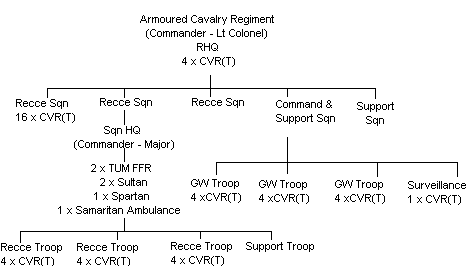|
Each of the three brigades in 3 United Kingdom Division will have its own
Armoured Cavalry Regiment structured and equipped to conduct a range of
enabling and reconnaissance tasks in all environments. Squadrons will
either work in their own Regimental Battle Group or be detached as
squadrons to support other Battle Groups in their brigade.
The basic task of Formation Reconnaissance is to obtain accurate
information about the enemy and develop an intelligence picture in their
areas of responsibility. Commanders rely on this up-to-the minute real
time intelligence to ensure effective counters are launched.
In a defensive scenario the Armoured Cavalry Regimentís task is to
identify the direction and strength of the enemy thrusts, impose maximum
delay and damage to the enemyís reconnaissance forces, while allowing
main forces to manoeuvre to combat the threat. They would be assisted in
such a task by using their own organic long range anti-tank guided
weapons and other assets that might be attached such as anti tank
helicopters (Lynx with TOW and perhaps Apache Longbow (WAH64D). In
support would be longer range artillery assets of the Brigade Artillery
inside an air defended area (ADA) maintained by Rapier and Stormer HVM
air defence missiles.
An Armoured Cavalry regiment will be structured around three Sabre
squadrons, a Command and Support squadron and a Headquarters squadron.
The Sabre squadrons will each have three Reconnaissance troops, each
with four vehicles, and a Support troop. The Command and Support
squadron will contain three Guided Weapons troops and a Surveillance
troop.

|